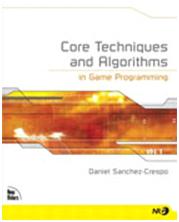 Core Techniques and Algorithms in Game Programming is one of those rare programming books that you really can judge by the cover.
Core Techniques and Algorithms in Game Programming is one of those rare programming books that you really can judge by the cover.
The author, Daniel Sanchez-Crespo—a regular contributor to Byte (Spain), Gamasutra and Game Developer—did an excellent and thorough job in the 800 pages that he had to work with. Throughout the book, even though English is not the author’s native language, he is clear and concise with every aspect of the technology he covers.
This is actually one of the books I recommend for students on my game programming courses at the Academy of G.E.T. in Hollywood—confirmation, in my mind, of the book’s intent of being a textbook.
Sanchez-Crespo begins with a brief chronology of games, moves on to the very basics of game architecture and the process of programming, then ramps up from there, thoroughly examining every aspect of the technology that makes a modern game, including the oft-neglected “input/update/render” loop. He doesn’t hang around either: he jumps feet-first into the common data structures (lists, queues and stack) and the not so common (deques, graphs and trees) that you will encounter, and examines what the Standard Template Library (STL) provides off-the-shelf. Sanchez-Crespo recognizes the power of the STL but also concedes that not all games should trade ease of implementation for degradation in speed.
Graphics plays a large part in the book, with several chapters dedicated to 2D and 3D rendering, along with the effects achievable in each area. 3D is a large subject and suitable for an entire volume all to itself, and Sanchez-Crespo performs a stellar job keeping each chapter tightly focused on the particular subject, introducing each technology at the proper pace.
3D is further divided to include indoor and outdoor rendering systems using chunked terrain rendering and portals of all types. Trailing the generic 3D sections is a large detailed detour in to character animation that covers skinned meshes and kinematics (both forward and inverse), as well as proper facial and limb animation systems.
The second largest area of this book is AI. Sanchez-Crespo really knows this subject. Outside of a dedicated book on game AI such as AI Programming Wisdom, this book offers some of the most comprehensive information on the subject delving into single unit and multiple unit navigation and coordination, using core AI techniques such as finite state machines and rule-based systems. The AI section alone makes owning the book well worth the shelf space.
Some of the shorter chapters cover networking, scripting, performance tuning, DirectX and OpenGL and their differences, an overview of the math required to get to grips with modern games technology, and finally the obligatory “further reading” section.
Just so you don’t get the impression this book is all hardcore programming, Sanchez-Crespo includes a chapter covering the cinematic aspects of games—something everybody involved in 3D games should learn, though it’s too brief for my liking. There’s even a chapter on design patterns, what they are, and their usage, including usability patterns (how the user interacts with the user interface)—a rare detour for a programming book.
Because the book is mostly API agnostic, it’s not going to suddenly go out of fashion like many API or narrow-focus books based on a particular technology.
Any book on general game programming is going to have to be brief in some areas simply because the domain is so broad. Sanchez-Crespo does a good job, covering so much in such a brief space you wonder how he got it all in.
Any subject you can think of pertaining to game programming is in this book, which is its strength and weakness. To do the subject justice, the book needs to be longer, and to the author’s credit he did the best job in the 800 pages provided. It’s a strong foundation book for aspiring game developers and there’s content in there for experienced developers too. It’s also a book you can give to a not-so-technical game designer and have them read through it to get a good foundation in many of the techniques and technologies that are being implemented by games programmers in studios all over the world. This book will definitely have a long shelf life.
This book review originally appeared March 3rd, 2004 on Gamasutra, the official webzine of Game Developer Magazine that I write for regularly.
ABOUT THE AUTHOR
Daniel Sanchez-Crespo Dalmau is a proffesor at Pempeu Fabra University in Barcelona, where he serves as founder and director of Europe’s first Master’s Degree in Video Game Creation. He has been teaching game programming for over six years, giving conferences all over Europe. He has been a course reviewer for SIGGRAPH and a member of the advisory board for ArtFutura. He is a frequent contributor to Byte Magazine Spain, Game Developer Magazine, and the Gamasutra web site, publishing over 40 articles. He is the founder of Novarama, and independent studio that focuses on creating innovative forms of entertainment for anything from PCs and consoles to cell phones and handheld devices.
VERDICT
Core Techniques And Algorithms In Game Programming
 Author: Daniel Sanchez-Crespo
Author: Daniel Sanchez-Crespo
Publisher: New Riders
ISBN: 0131020099
Pages: 912
Rating
10 out of 10
Pros
- Covers a lot of technical areas in-depth.
- Author explains the areas very carefully.
- The book contains a lot of information, not code dumps.
Cons
- Could use extra volumes expanding on the information presented.
- Some sections such as input & sound are far too brief to be useful.
- Lack of an accompanying CD-ROM of code and examples.



